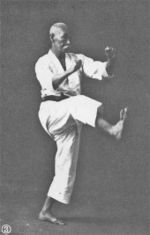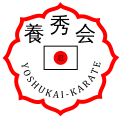Kūsankū (クーサンクー) is one of the kata of karate and is practiced mainly in the Shuri-te lineage. It is also called Kūshankū (クーシャンクー), Kōshōkun (公相君) or...
4 KB (492 words) - 12:07, 30 August 2024
although various guesses have been made to this day. The karate kata "Kūsankū" is said to be a kata taught by Kōshōkun, but there are no primary historical documents...
4 KB (442 words) - 20:21, 13 August 2024
Kata (Japanese: 形, or more traditionally, 型; lit. "form") is a Japanese word describing detailed patterns of movements practiced either solo or in pairs...
13 KB (820 words) - 05:54, 8 November 2024
Isshin-ryū (redirect from Sai Kata)
in the kata Chinto. Of the eight weaponless kata in Isshin-Ryu, five come from the teaching of Chotoku Kyan. Kusanku is one of these. Kusanku is often...
38 KB (5,536 words) - 16:23, 19 September 2024
stances, the balance of hard and soft techniques, and the number and names of kata forms. The four major karate styles developed in Japan, especially in Okinawa...
7 KB (396 words) - 22:47, 10 November 2024
Mabuni Kenwa Tōyama Kanken Tatsuo Shimabuku Important kata: Naihanchi sanchin (Shuri-te) Pinan Kūsankū Passai Jion Jitte Rohai Chinto Gojushiho The successor...
6 KB (663 words) - 10:42, 28 September 2024
Shōrin-ryū Seibukan (section Kata of Seibukan)
difficult of Sukunaihayashi kata. It is often regarded as the most beautiful kata of the style. Kusanku is the favorite kata of Hanshi Shimabukuro Zenpo...
14 KB (2,037 words) - 09:48, 2 October 2024
Motobu-ryū (section Kata)
an itosu no kushanku variation. (Kūsankū Dai) Motobu Kenpō is characterized by its emphasis on kumite as well as kata. Motobu Chōki learned kakidi (kakede...
21 KB (2,568 words) - 15:39, 23 September 2024
Shōrin-ryū (section Kata)
Shōrin-ryū Core Kata Naihanchi shodan nidan sandan Pinan shodan nidan sandan yondan godan Passai sho dai Gojushiho Dai Ni Gojushiho Chinto Kusanku sho dai Jion...
10 KB (994 words) - 19:17, 31 October 2024
Ryū-te (section Open Hand Kata)
with Shigeru Nakamura. Under Nakamura, Oyata learned 12 basic empty-hand kata that are practiced in Ryu-te today and helped establish Bogu Kumite as the...
25 KB (2,423 words) - 01:02, 10 June 2024
Passai (category Karate kata)
karate kata. According to Motobu Chōki, the Passai kata was one of the three most practiced kata in Okinawa, along with Naihanchi and Kūsankū, but was...
10 KB (1,291 words) - 06:57, 14 September 2024
Pinan (category Karate kata)
originated in Okinawa and were adapted by Anko Itosu from older kata such as Kusanku and Channan into forms suitable for teaching karate to young students...
6 KB (702 words) - 11:40, 30 August 2024
Matsubayashi-ryū (section Kata)
Shōshin Nagamine (1907–1997) (an Okina Sensei). Its curriculum includes 18 kata, seven two-man yakusoku kumite (pre-arranged sparring) routines, and kobudō...
12 KB (1,348 words) - 07:52, 16 October 2024
kata in the book are explained thoroughly, with pictures. Ten-i no Kata Chi-i no Kata Jin-i no Kata Sansai Koryū Naifanchi Koryū Bassai Koryū Kusanku...
12 KB (1,700 words) - 05:45, 15 April 2024
originator of the popular (Chatan) Yara Kusanku, Chatan Yara no Sai (iron truncheon), and Chatan Yara no Kon (6 foot staff) kata that are commonly found in Okinawan...
3 KB (326 words) - 10:34, 29 December 2023
learning many kata from this great master. It was Itosu who first developed the Pinan kata, which were most probably derived from the 'Kusanku' form. One...
9 KB (1,163 words) - 19:54, 30 August 2024
several years, learning many kata. It was Itosu who first developed the Pinan kata, which were possibly derived from the Kusanku form. One of his close friends...
20 KB (2,294 words) - 21:42, 17 September 2024
Yoshukai Karate (section Kata)
Japanese style from Chito-ryu (which still retains its strong Okinawan roots). Kata, kobudo, kumite, and all karate aspects are drawn from the Founder, Mamoru...
33 KB (4,219 words) - 14:05, 14 September 2024
Matsumura Sōkon (section Kata)
Shōrin-ryū Kempō-karate kata known as naihanchi I & II, passai, seisan, chintō, gojūshiho, kusanku (the embodiment of kusanku's teaching as passed on to...
6 KB (656 words) - 18:23, 22 April 2024
Kyan's best students and learned the kata: Seisan, Naihanchi, Wansu, Chinto and Kusanku, along with the weapons kata Tokumine nu kun and basic Sai. He also...
14 KB (1,875 words) - 17:09, 29 October 2024
Kusanku, as well as a Bō (6 ft staff) kata (Shishiryu no Bo), a Jo (4 ft staff) kata and a Sai (iron truncheon) kata (Nijushiho no Sai). Other kata were...
13 KB (1,583 words) - 15:11, 17 September 2024
Shōrin-ryū Shidōkan (section Thoughts on Kata)
dachi The kata practiced in Shidō-kan varies by dojo. The following series of kata are common to all: Kihon, Naihanchi, Pinan, Passai, Kusanku, Chinto,...
23 KB (2,595 words) - 17:45, 3 November 2024
Passai Dai, Kusanku Sho, Chinto, Kusanku Dai, and Gojushiho. Nakazato also created multiple weapons kata as well as the open hand form, Gorin Kata. Nakazato...
5 KB (419 words) - 18:42, 31 August 2024
instruction. Eizo Shimabuku also added two kata from his time in Goju-ryu with Chojun Miyagi. These kata being Seiyunchin and Sanchin (Eizo Shimabukuro...
4 KB (394 words) - 11:59, 31 August 2024
that it includes a few of Seikichi Odo's Kenpō and Kobujutsu kata, a few internal system kata, and a defense curriculum not based on Oyata's civilian teachings...
6 KB (771 words) - 23:46, 26 April 2024
Japanese) as learning steps for students, because he felt the older forms (kata in Japanese) were too difficult for schoolchildren to learn. The five Pinan...
10 KB (1,247 words) - 09:53, 30 August 2024











